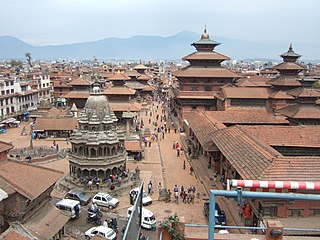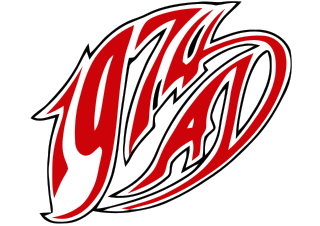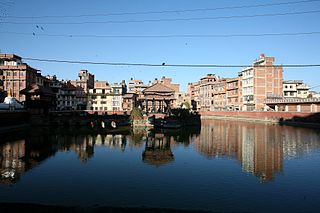Related Research Articles

Kathmandu, officially Kathmandu Metropolitan City, is the capital and most populous city of Nepal with 845,767 inhabitants living in 105,649 households as of the 2021 Nepal census and approximately 4 million people in its urban agglomeration. It is located in the Kathmandu Valley, a large valley in the high plateaus in central Nepal, at an altitude of 1,400 metres.

The Nepali Civil War was a protracted armed conflict that took place in the former Kingdom of Nepal from 1996 to 2006. It saw countrywide fighting between the Government of Nepal and the Communist Party of Nepal (Maoist), with the latter making significant use of guerrilla warfare. The conflict began on 13 February 1996, when the CPN (Maoist) initiated an insurgency with the stated purpose of overthrowing the Nepali monarchy and establishing a people's republic; it ended with the signing of the Comprehensive Peace Accord on 21 November 2006.

Newar or Newari, known officially in Nepal as Nepal Bhasa, is a Sino-Tibetan language spoken by the Newar people, the indigenous inhabitants of Nepal Mandala, which consists of the Kathmandu Valley and surrounding regions in Nepal.

Lalitpur Metropolitan City is a metropolitan city and fourth most populous city of Nepal with 299,843 inhabitants living in 49,044 households per the 2021 census. It is located in the south-central part of Kathmandu Valley, a large valley in the high plateaus in central Nepal, at an altitude of 1,400 metres.

The Pashupatinath Temple is a Hindu temple dedicated to Pashupati, a form of Shiva, and is located in Kathmandu, Nepal near the Bagmati River. This temple was classified as a World Heritage Site in 1979. This "extensive Hindu temple precinct" is a "sprawling collection of temples, ashrams, images and inscriptions raised over the centuries along the banks of the sacred Bagmati river", and is one of seven monument groups in UNESCO's designation of Kathmandu Valley. It is built on an area of 246 hectares and includes 518 mini-temples and a main pagoda house.

Kantipur Publications Pvt. Ltd. is a media firm based in Kathmandu, Nepal. The company operates five widely circulated print publications. It is the first media organization in Nepal to gain membership to the World Association of Newspapers and News Publishers (WAN). It was founded by Shyam Goenka in 1993 AD. Mr. Kailash Sirohiya is the chairman of the company.

1974 AD is a Nepali rock band, formed in Kathmandu, Nepal in the early 1990s. They experiment with various genres of music including Nepali folk, ragas, rock, funk, blues and jazz. 1974 AD are amongst the most successful recording artists in Nepal. Most of their albums are ranked amongst the top-ten best-selling albums according to Hits FM of Nepal. In 2000, their concert, 'Rock Yatra,' was watched by more than 60,000 people, the largest attendance for a concert in Nepal.

Kantipur is a Nepali language daily newspaper, published from Kathmandu, Biratnagar, Nepalgunj, and Bharatpur of Nepal simultaneously. It was founded by Shyam Goenka. Kantipur's publishers report that the circulation of this newspaper is just above 453,000 copies per day. It is regarded as the most widely read newspaper in Nepal; according to an audience survey in 2016, over half of those who read newspapers in Nepal were readers of Kantipur, considerably more than any other newspapers. The newspaper is also a source of information of homeland for Nepali diaspora.

Cricket Association of Nepal (CAN) is the official governing body of cricket in Nepal.

The Kathmandu Post is a major daily newspaper published in Nepal. Founded in February 1993 by Shyam Goenka, it is one of the largest English-language newspapers in the country. The newspaper is published by Kantipur Publications, the publishers of Nepal's largest selling newspaper, the Nepali-language Kantipur. Post is a member of the Asia News Network, an alliance of nineteen Asian newspapers. The Kathmandu Post is Nepal's first privately owned English broadsheet daily, and is Nepal's largest selling English language newspaper, with a daily circulation of 95,000 copies.

Karuna Ratna Tuladhar was a pioneer of Nepalese public transport. He was proprietor of Nepal Transport Service which he and his brother Lupau Ratna Tuladhar founded in 1959. This was Nepal's first public bus service which linked the capital Kathmandu with the railhead of Amlekhganj, 190 kilometers to the south near the Indian border.

Sahana Bajracharya is a Nepalese actress, tv host, model and beauty pageant titleholder who was crowned Miss Nepal Earth 2010. She was also the host of Mega Model Season 2, the local version of America's Next Top Model. She was the first woman to be on TNM Magazine. She was recently featured in Ruslan Vodka's advertisement. She was host in another show named Namaste TV show which was shown in NTV plus

The Battle of Kathmandu or siege of Kathmandu or siege of Kantipur occurred during the Unification of Nepal. It was fought in Kathmandu in 1768, and resulted in the defeat of its king Jaya Prakash Malla by conquerors Prithvi Narayan Shah, king of the adjoining Gorkha Kingdom.
Kanak Mani Dixit is a Nepali publisher, editor and writer. He is the founder of the magazine Himal Southasian and cofounder of Himal Media.

Govinda K.C. is a Nepali orthopaedic surgeon and philanthropic activist. He is a professor of orthopaedics at Tribhuvan University Teaching Hospital (TUTH), part of the Institute of Medicine, Nepal. He is known for his humanitarian work and for his activism in favor of the independent academic functioning of the government medical institutions of Nepal, notably the Institute of Medicine and Patan Academy of Health Sciences. His non-violent protests and fasts have successfully pressured the Nepali government and stakeholders to make change.

Satya Mohan Joshi was a Nepalese writer and scholar. Joshi is known for his research on the history and culture of Nepal. He also served as the chancellor of the Nepal Bhasa Academy.

Shree Krishna Shrestha was a Nepalese actor and producer known for his work in Nepali cinema. One of the most popular and celebrated stars of Nepali Cinema, Shrestha is renowned for his talents as an actor and dancer and was one of the highest-earning actors in Nepali cinema history.

Bagmati Province is one of the seven provinces of Nepal established by the constitution of Nepal. Bagmati is Nepal's second-most populous province and fifth largest province by area. It is bordered by Tibet Autonomous Region of China to the north, Gandaki Province to the west, Koshi Province to the east, Madhesh Province and the Indian state of Bihar to the south. With Hetauda as its provincial headquarters, the province is also the home to the country's capital Kathmandu, is mostly hilly and mountainous, and hosts mountain peaks including Gaurishankar, Langtang, Jugal, and Ganesh.

Pimbahal Pond is an artificial pond located in Lalitpur, Nepal. According to Nepalese folklore, the pond was built by Lakheys, a type of demon. In 1967, the Nepalese government tried to turn the pond into a market, but received local resistance. Pimbahal Pond was destroyed due to the 1934 Nepal–India earthquake and the April 2015 Nepal earthquake. But was rebuilt after those incidents.
The Nepal hostage crisis began on 19 August 2004 when an Iraqi Sunni insurgent group, Jamaat Ansar al-Sunna kidnapped and murdered twelve Nepalis.
References
- ↑ "Two killed in Kathmandu Valley". Kantipur Online. 2 September 2004. Archived from the original on 2 September 2004. Retrieved 2 August 2021.
- 1 2 3 4 5 6 7 8 9 10 11 12 13 14 "1 September, 2004". Nepali Times. Archived from the original on 29 July 2021. Retrieved 29 July 2021.
- ↑ Shrestha, Deepesh Das (8 September 2004). "Country in doldrums". Kantipur Online. Archived from the original on 8 September 2004. Retrieved 2 August 2021.
- ↑ "Refworld | Attacks on the Press in 2004 – Nepal". Refworld. Archived from the original on 29 July 2021. Retrieved 29 July 2021.
- ↑ "Protesters stone Nepal mosque after Iraq killings". China Daily. Archived from the original on 29 July 2021. Retrieved 31 July 2021.
- ↑ "Nepal: Himalayan Tranquillity Shattered By Religious Violence". Inter Press Service. 3 September 2004. Archived from the original on 29 July 2021. Retrieved 29 July 2021.
- ↑ Adhikary, Dhruba; Rohde, David (2 September 2004). "Nepalese Attack a Mosque and Muslims in Katmandu". The New York Times. ISSN 0362-4331. Archived from the original on 31 July 2021. Retrieved 31 July 2021.
- ↑ "Shame" (PDF). Nation Weekly. 21: 14–16. 12 September 2004. Archived (PDF) from the original on 29 July 2021. Retrieved 31 July 2021– via Digital Himalaya.
- ↑ "Indefinite curfew imposed in Kathmandu, Lalitpur". Kantipur Online. 1 September 2004. Archived from the original on 2 September 2004. Retrieved 2 August 2021.
- ↑ "One dies in Nepal protest against Iraq killings". The Sydney Morning Herald. 2 September 2004. Archived from the original on 29 July 2021. Retrieved 29 July 2021.
- 1 2 3 4 5 6 7 8 9 "Shame" (PDF). Nation Weekly. 21: 14–16. 12 September 2004. Archived (PDF) from the original on 29 July 2021. Retrieved 31 July 2021– via Digital Himalaya.
- ↑ "Enter the monster- Nepali Times". archive.nepalitimes.com. Archived from the original on 31 July 2021. Retrieved 31 July 2021.
- ↑ "Widespread protests in Nepal over killings 2 killed in firing; curfew in Butawal". The Tribune. 2 September 2004. Archived from the original on 29 July 2021. Retrieved 29 July 2021.
- ↑ "Nepal urges citizens to quit Iraq". BBC. 4 September 2004. Archived from the original on 31 July 2021. Retrieved 31 July 2021.
- ↑ "Curfew to be lifted from Kathmandu, Lalitpur on Monday". Kantipur Online. 5 September 2004. Archived from the original on 6 September 2004. Retrieved 2 August 2021.
- ↑ "Nepal hostage body found in Iraq". BBC. 3 September 2004. Archived from the original on 31 July 2021. Retrieved 31 July 2021.
- ↑ "All in a day's work". Nepali Times. Archived from the original on 2 August 2021. Retrieved 2 August 2021.
- 1 2 "Appeal for calm after Nepal riots". BBC. 1 September 2004. Archived from the original on 29 July 2021. Retrieved 29 July 2021.